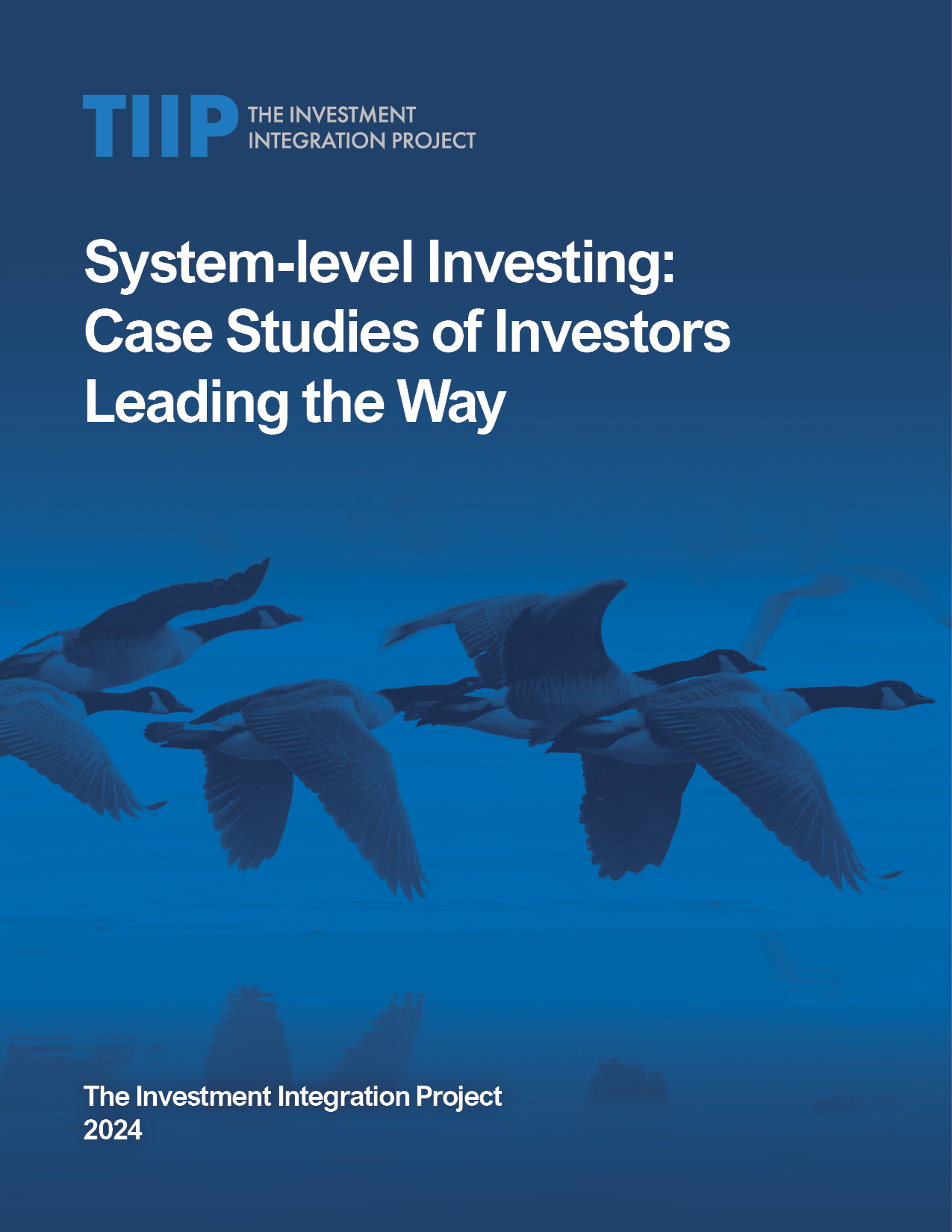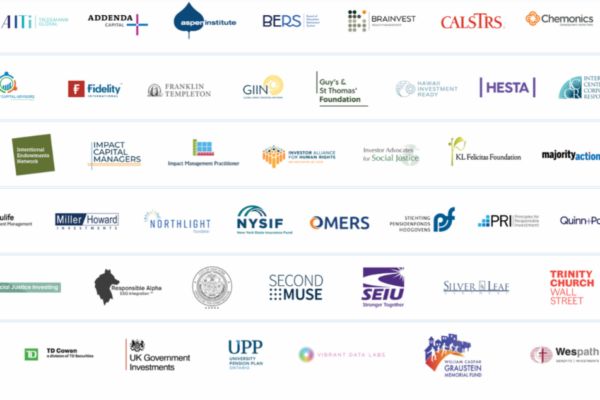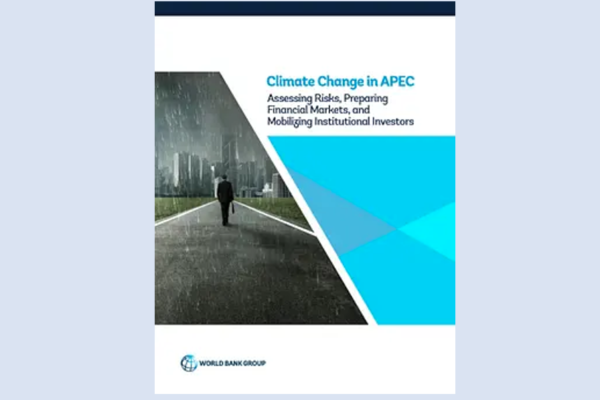New report includes detailed case studies on California State Teachers Retirement System (CalSTRS), Domini Impact Investments, Saint Paul & Minnesota Foundation (SPMF), University Pension Plan (UPP), and Wespath Benefits and Investments.
New York, April 10, 2024 – The Investment Integration Project (TIIP) announced today the release of a new report, System-level Investing: Case Studies of Investors Leading the Way. With the support of the Surdna Foundation, this report was developed as part of TIIP’s broader response to its industry needs assessment conducted in 2021 and 2022, which made clear that while stakeholders are concerned about the systemic nature of social and environmental issues and their connection to investment, there remains a clear need for more information and evidence to foster an accessible path for institutional investors to adopt system-level investing.
“The case studies provide a snapshot into the global community of practice of investors bridging the gap between systemic issues and their investment decision (or portfolios) using a diversity of approaches,” said William Burckart, the CEO of TIIP and co-author of the book 21st Century Investing: Redirecting Financial Strategies to Drive Systems Change. “They demonstrate where the field is headed and present a path forward for other investors to learn from their peers and join the evolution of investment,” said Burckart.
For this report, TIIP selected five investors known to be leading the way in acknowledging the importance of and incorporating system-level investing techniques to address systemic social and environmental risks and advance related solutions.
- California State Teachers Retirement System (CalSTRS), the largest teachers’ retirement system and second largest public pension fund in the U.S. with $315 billion in assets under management.
- Domini Impact Investments, a women-led investment adviser that focuses exclusively on impact investing, with a focus on forest and land use.
- Saint Paul & Minnesota Foundation (SPMF), the largest community foundation in Minnesota with $2 billion in assets under management.
- University Pension Plan (UPP), a jointly sponsored defined benefit pension plan created by and for Ontario’s university sector with $10.8 billion in pension assets.
- Wespath Benefits and Investments, a nonprofit pension fund and general agency of the United Methodist Church with over $24 billion in assets under management.
“Adapting to a changing world, these asset owners and managers are leading the next, critical shift in investment,” said Adam Connaker, the Director of Impact Investing for the Surdna Foundation. “They are adopting policies to transform conventional investment strategies in a way that both confronts systemic environmental and social challenges and makes financial sense,” said Connaker.
TIIP’s analysis of the case studies shows a field of system-level investing that is still carving out its norms and charting a course for success and replicability. While the newness of this investment trend can make it difficult to properly evaluate and analyze the effectiveness of their implementation, the report makes clear the ways in which early adopters are integrating these new strategies.
System-level investors start with adapting conventional investment techniques, first and foremost in their statements of investment beliefs and investment policies. From there, investors adopt advanced techniques, notably focusing on collaborating with like-minded firms to generate cross-industry engagement and amplify their influence. The advanced techniques that firms choose to utilize will differ depending on their size, capabilities, and thematic focus. A critical throughline is the presence of internal champions who play crucial roles in making their teams and boards aware of system-level investing and its merits.
“Investment risks, such as climate change, are not limited to individual securities. Rather, they are market-wide, systemic challenges,” said Aeisha Mastagni, Senior Portfolio Manager, CalSTRS. “As universal asset owners with a highly diversified portfolio, mitigating these risks is essential to support long-term value and to secure the pensions of California’s public educators and their beneficiaries,” said Mastagni.
“It is exciting to see system-level investing move from a theoretical proposal to concrete work as investors begin putting it into practice. We at Domini have long been advocates of TIIP’s work, as well as practitioners, recognizing its role in helping to address some of society’s most pressing challenges,” said Carole Laible, CEO, Domini Impact Investments. “The groundbreaking work of these early adopters will lay a clear path for the financial community. Congratulations to TIIP for compiling these case studies as a critical reference for all investors,” said Laible.
“As a foundation viewing our investment practices through a community-focused lens, we seek to manage our financial investments in a way that generates sustainable financial and social returns, aligned to the systemic challenges our nonprofit partners are trying to solve,” said Shannon O’Leary, Chief Investment Officer, Saint Paul & Minnesota Foundation. “By aligning our investments with our greater purpose—in our case, inspiring generosity, advocating for equity and investing in community-led solutions—we can achieve strong financial returns and social benefits as well,” said O’Leary. Alex Rotenberger, Senior Investment Analyst, added, “We also use our learnings as a starting point for conversations within our circles of influence, working with external fund managers on more equitable practices within their own firms, for example.”
“For UPP, integrating a systems-level approach to our investing activities means accounting for environmental, social, and governance (ESG) factors at every stage of the investment process. This approach extends to our external investment partners and industry peers, with which we seek to continuously improve performance in these areas,” said Brian Minns, Senior Managing Director, University Pension Plan. “As a long-term investor, these efforts help position us to manage risk, derive and protect value in line with our fiduciary duty to our members, and contribute to healthy, resilient, and sustainable capital markets today and for generations to come,” said Minns.
“Wespath has built our sustainable investing program around the belief that addressing many of the risks investors are facing requires a systemic lens,” said Jake Barnett, Managing Director of Sustainable Investment Strategies, Wespath Benefits and Investments. “TIIP helps us better understand and consider these risks, and determine actionable steps to address them,” said Barnett.
Lucas Schoeppner, Manager, Sustainable Investment Stewardship, Wespath Benefits and Investments, added, “The Investment Integration Project and their SAIL platform helps us articulate our views on systems-level issues and structure them into practical actions that can be incorporated into the investment process. This can include setting expectations and monitoring progress with asset managers on climate, or informing policy and corporate engagement on income inequality,” said Schoeppner.
With these five investors as examples, a roadmap begins to form, charting a path for investors to incorporate system-level investing techniques. The case studies and analysis show a replicable order of operations and necessary set of ingredients that support this approach. These components are compiled in TIIP’s new SAIL platform, which provides in-depth guidance for investors to embark on their journey to becoming or strengthening their system-level beliefs and techniques.
Read the report here.
About The Investment Integration Project (TIIP)
TIIP helps investors understand how healthy social, environmental, and financial systems can benefit their portfolios. TIIP provides consulting services, applied research, and a turnkey solution (SAIL) that supports investors’ pursuit of system-level investing, an advanced approach to sustainable and impact investing that focuses on managing systemic risks and investing in solutions to systemic problems. For more information, visit https://www.tiiproject.com.




